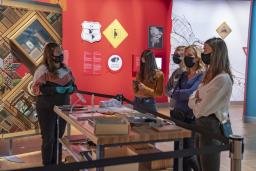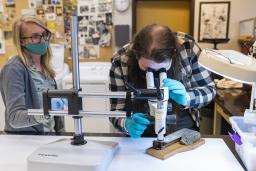The Witness Blanket contains over 800 items gathered from sites and Survivors of Indian residential schools in every region of Canada. This exhibition showcases work being done to preserve the profound knowledge and experiences embedded in this powerful artwork – so future generations can continue bearing witness to its presentation of the genocide committed against the original peoples of this land.
Witness Blanket: Preserving a Legacy (Level 1 Gallery)
April 30, 2021 to March 26, 2022
This exhibition has passed.
Tags:

Photo: CMHR, Jessica Sigurdson
Exhibition details
The Museum collaborated with staff from the Canadian Conservation Institute to understand the care required, and it has enlisted the expertise of the conservation team from the Manitoba Museum to lead this project. Treatments are occurring in our Level 1 Gallery, as well as at the Manitoba Museum’s conservation laboratory.

In addition to the collaborative work of experts from both museums, a conservation technician with an Indigenous perspective from Mniwakan Oyate (Spirit Lake Dakota Nation) joined our team for several months. Skylar Wall gained valuable experience working in the field of conservation in a museum, learned about the preservation of tangible and intangible heritage, and shared ideas.
More than 130 Indian residential schools operated across Canada. They were a deliberate attempt to destroy Indigenous communities and ways of life. This system was part of a broader process of colonization and genocide.

Conservation of the Witness Blanket is critical because it not only represents Canada’s human rights history and the genocide committed, but also offers an opportunity to advance discussion about genocide and reconciliation. The preservation approach for these tangible and intangible pieces of the past respects the Stories and people involved, and honours our commitment to uphold their cultural and spiritual significance. In keeping with a unique stewardship agreement reached with the artist, we act in accordance with traditional teachings that include respect, humility, love, truth, honesty, courage and wisdom.
Many of the artifacts are living and spiritual objects, which the conservation project team members consider as they plan and carry out their work. For example, some are honoured by leaving the evidence of their histories intact, such as accumulated rust, lichen or scratches, while others will be allowed to naturally age and deteriorate. The conservation project team is carefully working to ensure they align their processes and ethical conservation practices with the artist’s intention.
The conservation project team and the artist work collaboratively to determine which materials are used in the various treatments, which often means choosing natural over synthetic materials and limiting the use of chemicals. Reversible practices ensure that anything done to each piece can also be undone if needed, now or in the future.

Witness Blanket: Preserving a Legacy is presented alongside Artivism, an exhibition that explores artistic expression as a response to large‐scale violations of human rights.
Dive Deeper
The Witness Blanket
This monumental work of art honours Survivors of Canada’s residential schools. A new website lets you learn from their experiences and bear witness to their stories.
